Related Research Articles

Benito Pablo Juárez García was a Mexican liberal politician and lawyer who served as the 26th president of Mexico from 1858 until his death in office in 1872. A Zapotec, he was the first indigenous president of Mexico, and the first indigenous head of state in the postcolonial Americas.
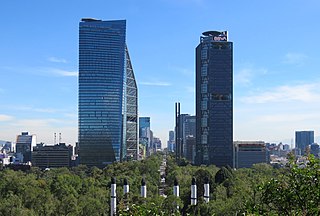
Paseo de la Reforma is a wide avenue that runs diagonally across the heart of Mexico City. It was designed at the behest of Emperor Maximilian by Ferdinand von Rosenzweig during the era of the Second Mexican Empire and modeled after the great boulevards of Europe, such as the Ringstraße in Vienna and the Champs-Élysées in Paris. The planned grand avenue was to link the National Palace with the imperial residence, Chapultepec Castle, which was then on the southwestern edge of town. The project was originally named Paseo de la Emperatriz in honor of Maximilian's consort Empress Carlota. After the fall of the Empire and Maximilian's subsequent execution, the Restored Republic renamed the Paseo in honor of the La Reforma.

Naucalpan, officially Naucalpan de Juárez, is one of 125 municipalities located just northwest of Mexico City in the adjoining State of Mexico. The municipal seat is the city of Naucalpan de Juárez, which extends into the neighboring municipality of Huixquilucan.

The Juárez Cartel, also known as the Vicente Carrillo Fuentes Organization, is a Mexican drug cartel based in Ciudad Juárez, Chihuahua, across the Mexico—U.S. border from El Paso, Texas. The cartel is one of several drug trafficking organizations that have been known to decapitate their rivals, mutilate their corpses and dump them in public places to instill fear not only into the general public, but also into local law enforcement and their rivals, the Sinaloa Cartel. Its current known leader is Juan Pablo Ledezma. The Juárez Cartel has an armed wing known as La Línea, a Juárez street gang that usually performs the executions and is now the cartel’s most powerful and leading faction. It also uses the Barrio Azteca gang to attack its enemies.
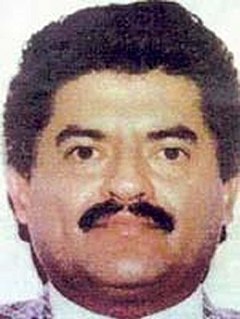
Juan José Esparragoza Moreno, commonly referred to by his alias El Azul, was a Mexican drug lord and leader of the Sinaloa Cartel, a drug trafficking organization. Originally a member of the Dirección Federal de Seguridad (DFS) police agency, he founded the Guadalajara Cartel in the 1970s along with other drug kingpins in Mexico. Following its disintegration in the late 1980s, he went on to lead the Juárez Cartel and eventually settled in the Sinaloa Cartel. He worked alongside Joaquín "El Chapo" Guzmán, once considered Mexico's most-wanted drug lord.
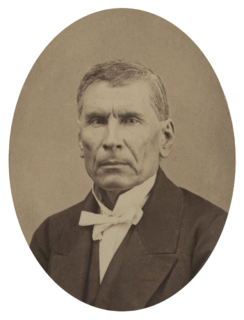
José Santiago Vidaurri Valdez was a controversial and powerful governor of the northern Mexican states of Nuevo León and Coahuila between 1855 and 1864. He was an advocate of federalism.

La Línea is currently the leading faction of the Juárez Cartel originally designed to be one of the cartel's enforcer units set up by a number of former and active-duty policemen, heavily armed and extensively trained in urban warfare. Their corrupt "line" of policemen were set up to protect drug traffickers, but after forming an alliance with Barrio Azteca to fight off the forces of the Sinaloa Cartel in 2008, they established a foothold in Ciudad Juárez as the enforcement wing of the Juárez cartel. La Línea has also been involved in extortions and kidnappings. As of 2021, La Línea has formed an alliance with the Jalisco New Generation Cartel in Ciudad Juárez to fight off influence and incursions from the Sinaloa Cartel.

Colonia Cuauhtémoc is a colonia in the Cuauhtémoc municipality of central Mexico City. It is located just north of Paseo de la Reforma, west of the historic center of Mexico City.
Gente Nueva, also known as Los Chapos, in reference to their drug lord Joaquín Guzmán Loera, is a large group of well-trained and experienced gunmen that function as one of the elite armed wings of the Sinaloa Cartel, created to counter, battle and destroy the Juárez Cartel's influence in the Mexican north-west, as well as to battle and destroy La Línea which is currently the Juárez Cartel's largest remaining cell.

The status of women in Mexico has changed significantly over time. Until the twentieth century, Mexico was an overwhelmingly rural country, with rural women's status defined within the context of the family and local community. With urbanization beginning in the sixteenth century, following the Spanish conquest of the Aztec empire, cities have provided economic and social opportunities not possible within rural villages. Roman Catholicism in Mexico has shaped societal attitudes about women's social role, emphasizing the role of women as nurturers of the family, with the Virgin Mary as a model. Marianismo has been an ideal, with women's role as being within the family under the authority of men. In the twentieth century, Mexican women made great strides towards a more equal legal and social status. In 1953 women in Mexico were granted the right to vote in national elections.
Feminism in Mexico is the philosophy and activity aimed at creating, defining, and protecting political, economic, cultural, and social equality in women's rights and opportunity for Mexican women. Rooted in liberal thought, the term feminism came into use in the late nineteenth-century Mexico and in common parlance among elites in the early twentieth century. The history of feminism in Mexico can be divided chronologically into a number of periods, with issues. For the conquest and colonial eras, some figures have been re-evaluated in the modern era and can be considered part of the history of feminism in Mexico. At independence in the early nineteenth century, there were demands that women be defined as citizens. The late nineteenth century saw the explicit development of feminism as an ideology. Liberalism advocated secular education of both girls and boys as part of a modernizing project and women entered the workforce as teachers. Those women were at the forefront of feminism, forming groups that critiqued existing treatment of women in the realm of legal status, access to education, and economic and political power. More scholarly attention is focused on the Revolutionary period (1915–1925), although women's citizenship and legal equality were not explicitly issues for which the revolution was fought. The Second Wave, and the post-1990 period have also received considerable scholarly attention. Feminism has advocated for equality of men and women, but middle-class women took the lead in the formation of feminist groups, the founding of journals to disseminate feminist thought, and other forms of activism. Working-class women in the modern era could advocate within their unions or political parties. The participants in the Mexico 68 clashes who went on to form that generation's feminist movement were predominantly students and educators. The advisers who established themselves within the unions after the 1985 earthquakes were educated women who understood the legal and political aspects of organized labor. What they realized was that to form a sustained movement and attract working-class women to what was a largely middle class movement, they needed to utilize workers' expertise and knowledge of their jobs to meld a practical, working system. In the 1990s, women's rights in indigenous communities became an issue, particularly in the Zapatista uprising in Chiapas. Reproductive rights remain an ongoing issue, particularly since 1991 when the Catholic Church in Mexico is no longer constitutionally restricted from being involved in politics.
The following is a timeline of the history of the city of Chihuahua, Mexico.
Instituto Simón Bolívar (ISB) is a private school in Xoco, Benito Juárez, Mexico City. It serves levels preschool through high school (preparatoria). There is a branch campus in Toluca, also serving preschool through high school.
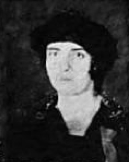
Elena Torres Cuéllar was a leading Mexican revolutionary, feminist, progressive educator and writer. A member of the communist party, in 1917 she was the only woman to participate on behalf of the Liga Central de Resistencia at the first meeting of the Yucatán Socialist Party in Mérida. In 1919, she founded the Mexican Feminist Council campaigning for better social and economic conditions for women as well as the right to vote. She devoted considerable efforts to improving education in Mexico, especially by facilitating the training of primary school teachers in rural areas.
Julia Nava de Ruisánchez, also Ruiz Sánchez, was a Mexican writer and an activist during the Mexican Revolution. She is also remembered for establishing the first Mexican institution for training social workers in 1936.
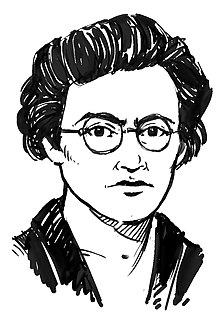
Eulalia Guzmán Barrón (1890–1985) was a pioneering feminist and educator and nationalist thinker in post-revolutionary Mexico. She was one of the first women to work in the field of Mexican archeology. She was the lead investigator of the remains found in Ixcateopan, Guerrero, which she alleged to be those of the last Aztec Emperor, Cuauhtémoc. Three boards of inquiry on the archeological work done at the site refuted Guzmán's findings, calling her field methods into question. Her lasting legacy was the collection of Mexico's history from archives throughout the world and creation of the National Library of Anthropology and History.
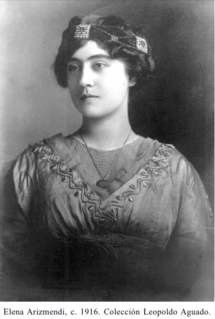
Elena Arizmendi Mejía was a Mexican feminist who established the Neutral White Cross to care for casualties of the Mexican Revolution that the Red Cross would not aid. Participating in the first wave of Mexican feminism, she established two international women's rights organizations: the "Mujeres de la Raza" and the International League of Iberian and Latin American Women.
Hijas de Cuauhtémoc was a student Chicana feminist newspaper founded in 1971 by Anna Nieto-Gómez and Adelaida Castillo while both were students at California State University, Long Beach.
Polvo de Gallina Negra (in Spanish: Black hen powder) was a collective founded by Mexican visual artists Maris Bustamante and Mónica Mayer in 1983, the first group of the feminist art genre in Mexico. For ten years, their activities included demonstrations, exhibitions, conferences, publication of texts, participation in media, performance, curatorship, and mail art. Bustamante wrote, “[W]e grew while we built our families, so we had a lots of fun discovering that the social and cultural reality is penetrable.”

1917 Bath Riots occurred in January 1917 at the Santa Fe Bridge between El Paso, Texas and Juárez, Mexico. The riots are known to have been started by Carmelita Torres and lasted from January 28 to January 30 and were sparked by new immigration policies at the El Paso–Juárez Immigration and Naturalization Service office, requiring Mexicans crossing the border to take de-lousing baths and be vaccinated. Reports that nude photographs of women bathers and fear of potential fire from the kerosene baths, led Carmelita Torres to refuse to submit to the procedure. Denied a refund of her transport fare, she began yelling at the officials and convinced other riders to join her. After three days, the discontent subsided, but the disinfections of Mexicans at the U.S. border continued for forty years.
References
- ↑ Ruiz, Ramón Eduardo (1992). Triumphs and tragedy : a history of the Mexican people . New York: W.W. Norton. p. 284. ISBN 9780393310665.
- 1 2 3 Soto, Shirlene (1990). Emergence of the modern Mexican woman : her participation in revolution and struggle for equality, 1910-1940 . Denver, Colo.: Arden Press. p. 16. ISBN 0912869119.